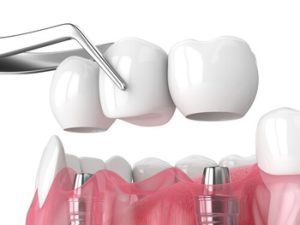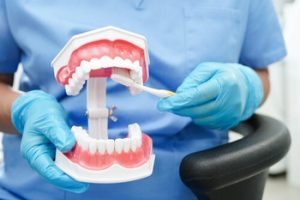Losing a tooth can change the way you eat, speak, and feel about your smile. A dental bridge provides a lasting solution, helping to restore both function and confidence. While many people consider this treatment, they often wonder about the costs involved. Multiple factors influence the final price, making it important to explore what contributes to the overall expense. Understanding these elements can help in making a well-informed decision about tooth replacement. With the right approach, restoring a missing tooth can offer both aesthetic and functional benefits.
What Is a Dental Bridge?
A dental bridge is designed to replace missing teeth, restoring both function and appearance. It relies on adjacent teeth for support, ensuring stability while filling the gap left by lost teeth. This structure blends with natural teeth, allowing for a balanced bite and a seamless look. By addressing missing teeth, these false teeth help maintain dental alignment and overall oral health.
What Is the Average Cost of a Dental Bridge?
The starting price for a dental bridge in Australia is around $1,500 per tooth. Visiting a dentist allows you to get a personalised cost estimate. They will assess your oral condition and suggest the most effective solution.
What Are the Key Elements That Affect the Cost of a Dental Bridge?
Understanding what contributes to the overall expense can help individuals plan their treatment effectively.
 Material Used in the Dental Bridge
Material Used in the Dental Bridge
The type of material selected plays a crucial role in determining the bridge cost. Options such as porcelain, metal, or a combination of both impact durability, aesthetics, and overall pricing. While metal-based bridges offer strength, they may not match the natural shade of surrounding teeth. On the other hand, ceramic or porcelain bridges provide a more natural look but tend to be priced higher. The choice of material should balance longevity with visual appeal based on individual needs.
Number of Teeth Being Replaced
The total tooth bridge cost is influenced by how many missing teeth need to be restored. A single tooth replacement generally costs less than a bridge designed to replace multiple missing teeth. The complexity of creating a structure that supports more than one tooth can add to the overall expense. Bridges covering a larger area require additional materials and customisation to ensure stability and functionality. The final cost reflects the extent of restoration needed to achieve a seamless and effective result.
Type of Bridge Chosen
Different bridge designs have varying price points based on their structure and functionality. Traditional dental bridges rely on adjacent teeth for support and are generally more affordable than implant-supported bridges. Implant-based solutions eliminate the need for modifying neighbouring teeth but involve additional procedures, increasing the overall treatment cost. Choosing between these options depends on oral health conditions, long-term benefits, and personal preferences. The selection process often involves balancing affordability with durability.
The Role of Supporting Dental Crowns
In cases where a bridge is attached to natural teeth, dental crowns are required to secure the structure. The type of crown used impacts the cost of dental bridges since materials like porcelain, ceramic, or metal vary in price. Crowns need to be customised to match the natural bite and appearance, which requires precise crafting. The complexity of preparing the supporting teeth to accommodate the crowns also contributes to the overall expense. Since these crowns provide the foundation for the bridge, their quality plays a direct role in longevity.
Additional Procedures Required
In some cases, preparatory treatments may be needed before a bridge can be placed. If the supporting teeth are weak or damaged, they may require fillings or root treatments before the procedure. In situations where bone loss has occurred, dental implants may be recommended as an alternative, further influencing the total dental bridge cost. Addressing any underlying issues ensures that the bridge remains stable and functions as intended. The need for extra steps varies from patient to patient and can affect the final pricing.
Location and Dental Expertise
The cost of dental treatment can differ based on location and the expertise of the dentist providing care. Clinics in metropolitan areas may charge more due to higher operational expenses, whereas regional practices might offer more affordable options. Additionally, a highly experienced practitioner may have higher fees due to advanced techniques and a history of successful treatments. Choosing a provider should involve assessing both skill level and cost considerations to ensure a balance between quality and affordability.
Customisation and Laboratory Fees
Since dental bridges are tailored to fit each individual’s mouth, the customisation process affects pricing. The more detailed the work, the higher the associated cost, particularly when intricate shaping and shading are required for a natural look. Laboratory fees also contribute to the total, as skilled technicians design and create bridges based on impressions. High-quality craftsmanship ensures a comfortable and durable fit, but it may come at a higher cost. The extent of personalisation directly influences the overall price of treatment.
How Does the Process of Getting a Dental Bridge Work?
Initial Consultation and Treatment Planning
The first step in the process involves an assessment by a dentist to determine whether a bridge is the right solution. A thorough examination helps evaluate the condition of the surrounding teeth and the overall structure of the mouth. X-rays or digital scans may be taken to get a clear picture of the jawbone and remaining teeth. If any concerns, such as gum disease, are detected, they may need to be addressed before proceeding with the treatment. Once the assessment is complete, a personalised treatment plan is designed based on the patient’s specific needs.
Preparation of Supporting Teeth
For traditional dental bridges, the teeth on either side of the gap serve as anchors. These teeth are reshaped to create space for crowns, which will hold the bridge securely in place. During this step, a local anaesthetic is often used to ensure comfort while adjusting the structure of the teeth. The amount of reshaping required depends on the size and placement of the bridge.
 Taking Impressions for a Custom Fit
Taking Impressions for a Custom Fit
A detailed impression of the reshaped teeth is taken to ensure an accurate fit for the new bridge. This mould is forwarded to a dental lab, where technicians design a customised restoration that complements the patient’s bite. Every aspect, including size, shape, and colour, is carefully matched to create a natural-looking result. While the permanent tooth bridge is being fabricated, a temporary bridge is fitted to cover the exposed teeth. This temporary solution helps protect the area, allowing the patient to chew and speak normally until the final bridge is ready.
Fitting and Securing the Bridge
Once the custom bridge is ready, the patient returns for the final fitting. The temporary restoration is carefully removed, and the permanent bridge is placed for evaluation. The dentist checks the fit, alignment, and bite to ensure comfort and stability. Adjustments may be made if necessary before securing the bridge with dental cement. If an artificial tooth root is used as part of an implant-supported bridge, it must be fully integrated with the jawbone before the final placement.
Ensuring a Comfortable Fit and Long-term Success
After placement, the dentist provides guidance on how to care for the new restoration. Proper oral hygiene helps maintain the longevity of the bridge and prevents complications such as decay or gum irritation. Routine check-ups allow the dentist to monitor the bridge’s condition and make any necessary adjustments over time. Patients are encouraged to follow recommended care practices to protect both the bridge and their oral health. With the right approach, a well-placed bridge can offer reliable function and a natural-looking smile for years.
Each stage of the process plays a crucial role in achieving a successful result. Consulting with a dentist can provide further insight into what to expect and ensure the most effective outcome for long-term dental stability.
Book Your Consultation with Our Dental Team
Investing in a dental bridge can enhance both function and confidence, making it a worthwhile decision. Understanding the cost helps in planning the treatment that most fits your needs. Our team is here to guide you through your options and ensure you receive quality care that supports long-term dental health. Whether you need a single replacement or a more extensive solution, we offer personalised advice tailored to your situation. Do not wait to restore your smile. Please call us at (02) 4501 7930 to discuss your options and schedule your consultation today.
References
https://www.webmd.com/oral-health/dental-health-bridges
https://www.medicalnewstoday.com/articles/327182



